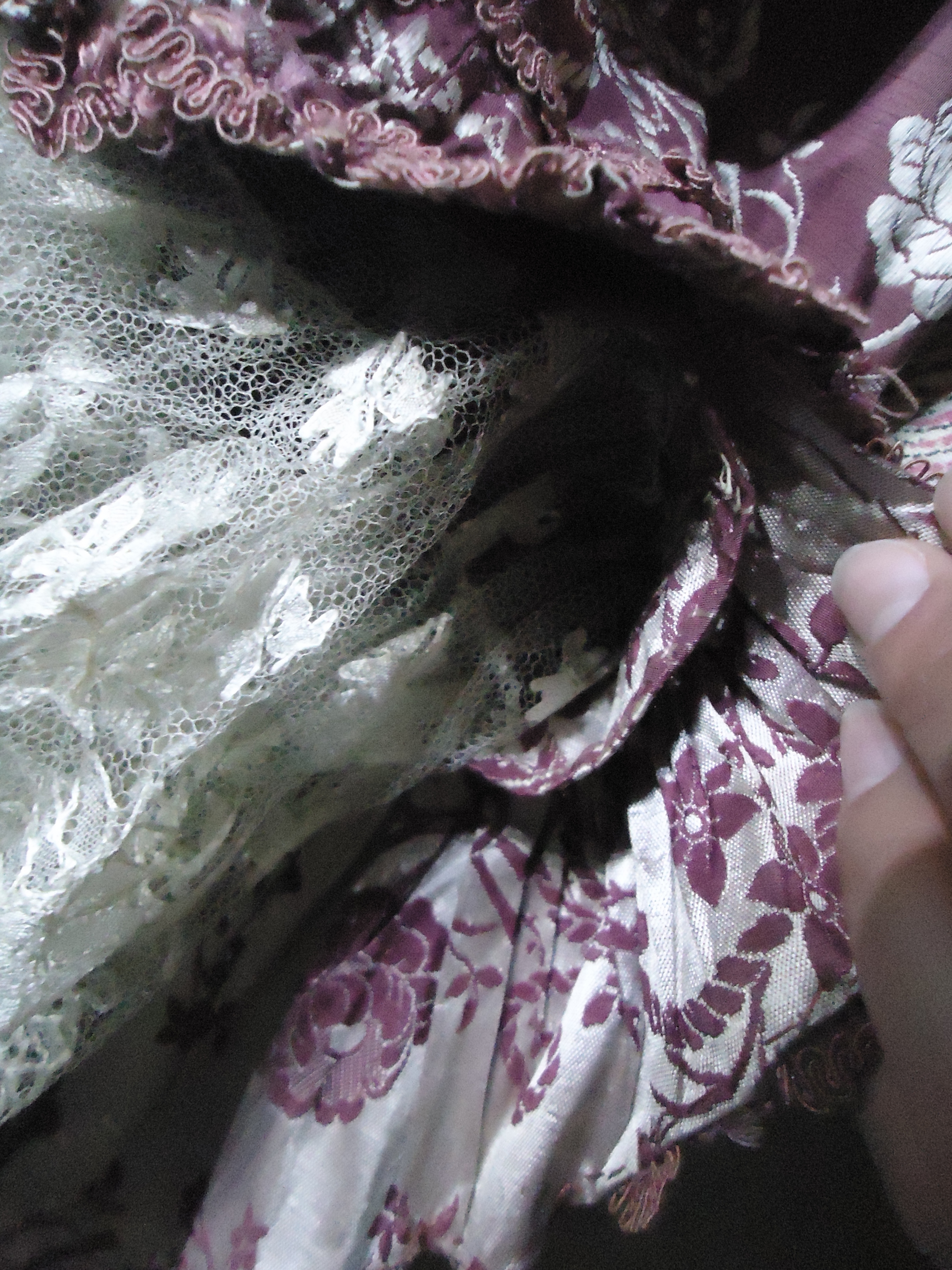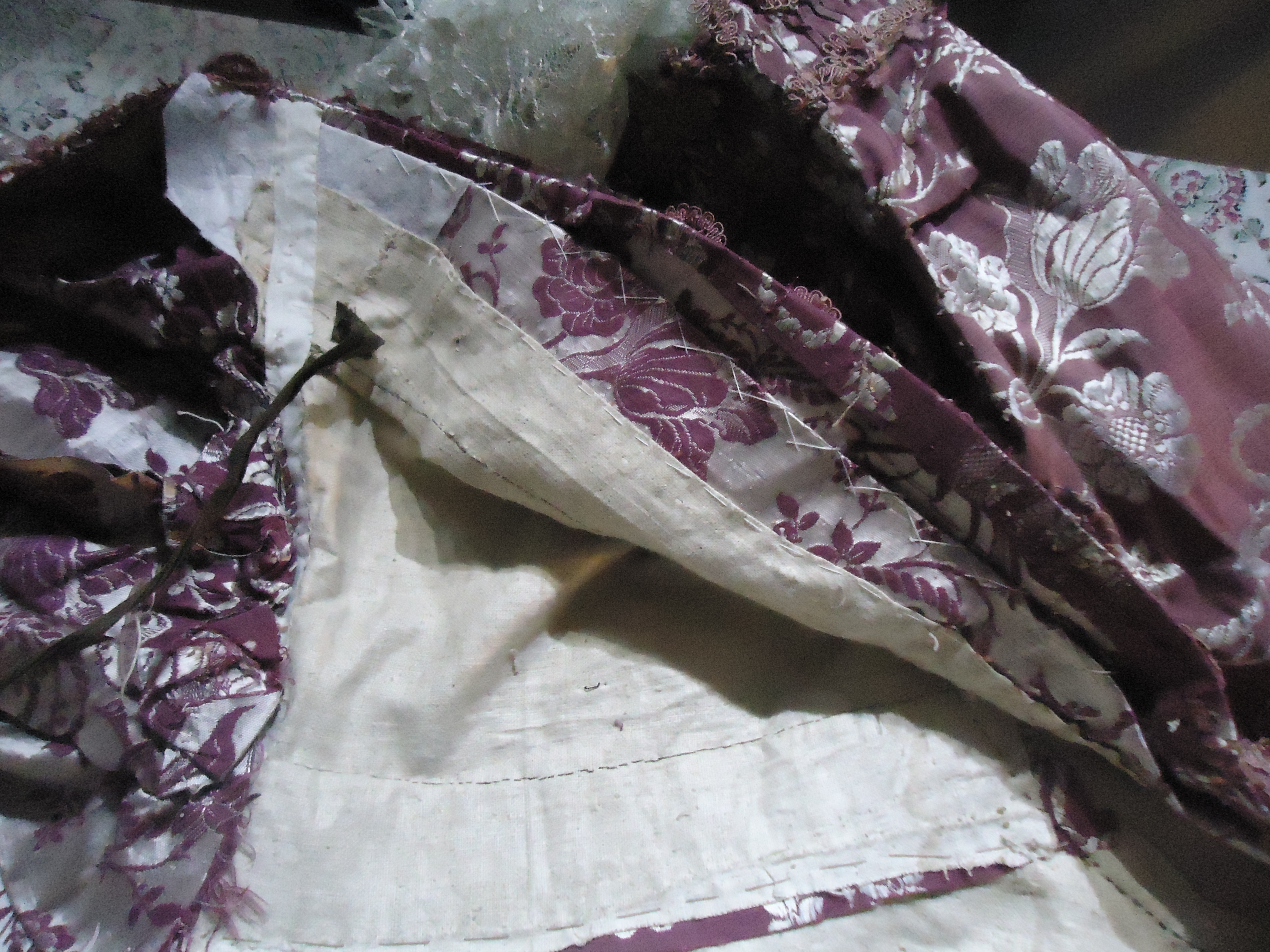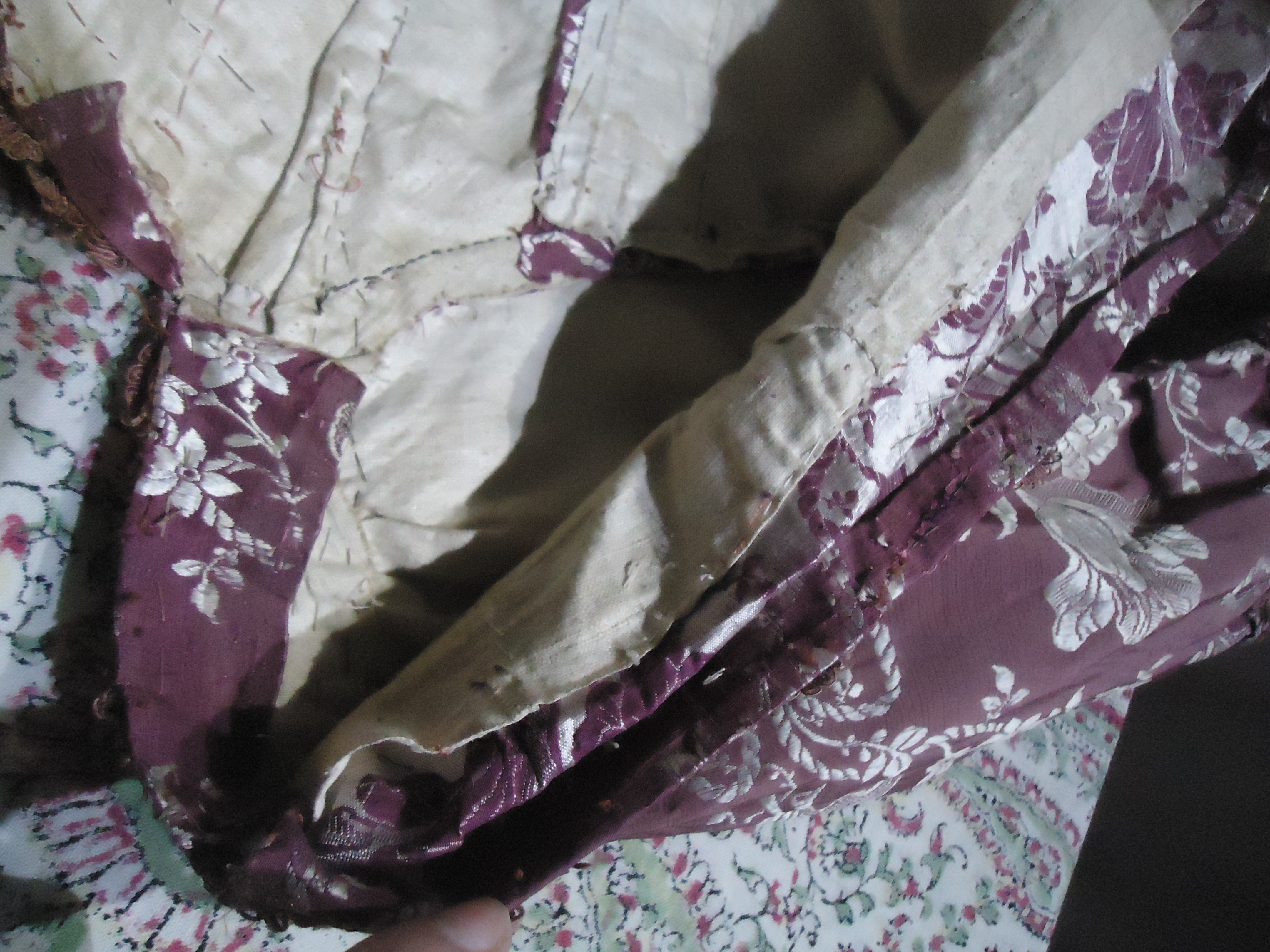A Robe a l'Angais of Ruby Silk:
c.1760
(All these images are used with permission from the Totnes Fashion and textile Musuem)
Ruby Silk Robe a l'Anglais.
c.1760
Details:
- Open Gown with both open bodice to reveal stomacher/stays and open gown to reveal petticoat.
- Robings either side and decorated with furbelows.
- Furbelows also trim down the CF skirt and around the cuffs
- Furbelow is quite tight with fabric, being very mean with the gathers and comes across almost flat. Fly trim decorates either side.
- Bodice is linen lined.
- Two tiered ruffle cuff with fly trim at the end of each ruffle.
- Ruffles sewn onto sleeve leaving a band on the inside for sewing flounces or lace ruffles onto.
- Furbelow trim is same depth at back neck as on front.
- Bodice has dart at front and then a two panelled back with CB panel going into the skirts.
- No Pocket openings
- Robings fold Herringboned Stitched down.
- 1/4 Inch raw selvedge seams.
- Furbelows sewn down with a Stab stitch.
- Petticoat has a curved hemmed Trim.
- CB Pleats have been Stab stitched down
- Open Gown with both open bodice to reveal stomacher/stays and open gown to reveal petticoat.
- Robings either side and decorated with furbelows.
- Furbelows also trim down the CF skirt and around the cuffs
- Furbelow is quite tight with fabric, being very mean with the gathers and comes across almost flat. Fly trim decorates either side.
- Bodice is linen lined.
- Two tiered ruffle cuff with fly trim at the end of each ruffle.
- Ruffles sewn onto sleeve leaving a band on the inside for sewing flounces or lace ruffles onto.
- Furbelow trim is same depth at back neck as on front.
- Bodice has dart at front and then a two panelled back with CB panel going into the skirts.
- No Pocket openings
- Robings fold Herringboned Stitched down.
- 1/4 Inch raw selvedge seams.
- Furbelows sewn down with a Stab stitch.
- Petticoat has a curved hemmed Trim.
- CB Pleats have been Stab stitched down
We know these photo's appear quite dark but the lighting is specially designed to protect the cloth and obviously a flash wasn't allowed. But we believe you can still see the details clearly - enough to be able to learn from them.
What we have following are images of close-up parts of the gown while it was on the table awaiting to be dressed onto the mannequin. In the above image you can see the furbelow trim edging the robings and the skirt and you can see the lined bodice and pleated top of the skirt.
The amazing thing when you study and visit these dresses is sometimes, however mind blowing the fabric is and the excitement of seeing something 200 years old, you can still get an idea of when a dress was quickly or slightly more on the cheap. This is a fairly simple example of a Robe a l'Anglais, fairly slim on the CB pleats, mean on the trim and basic in the pleatage system around the waistline of the skirt. You can well imagine the lady putting most of the money into the fabric and not having much left to pay the tailor.
Here's an example of the way the sleeve has had the ruffles sewn on, leaving the band beneath. As you can see the Ruffles have been sewn down higher up onto the sleeve, leaving this protrusion that can be used to sew the lace ruffles onto.
To the left here, is an image showing in close detail the size and gathering of the furbelow with Fly Trim. the Fly trim has been applied much more generously and the Furbelow much tighter gathered. I wonder why really, was it that the sleeves were a particularly noticeable spot? I can't see them being any more noticeable than the whole front of the dress. Or could it be that in the pattern cutting it was easier to get a these tinier strips out than it was for the wide and longer lengths needed for the front trim?
I obviously had a relatively short time and between taking photo's, helping hold doors open and taking super-quick sketches, there wasn't really loads of time for taking measurements and such.
I'm going to include my rather bad sketch and notes of this dress aswell as it may help complete the picture and I dare anyone to be able to read my scribbled notations. When I sketch I always think, 'this drawing is not so important: I have the photos as the main records' but then when I see the photos I think 'what I need is my drawings with all the notes arrowed in'. But I hope you find both of them useful.
I'm going to include my rather bad sketch and notes of this dress aswell as it may help complete the picture and I dare anyone to be able to read my scribbled notations. When I sketch I always think, 'this drawing is not so important: I have the photos as the main records' but then when I see the photos I think 'what I need is my drawings with all the notes arrowed in'. But I hope you find both of them useful.
Here's a quick image of how flat the Furbelow trim at the front of the dress looks (please look right):
- This next image is a close-up of the top of the Bodice and shoulder including a detailed shot of the Furbelow and Fly Trim. You can see the stitching even from this photo, see how the Fly Trim has been gathered up and set into curves - It's like they've pulled one thread and then held it into place by catching it down. And see the barely-gathered Furbelow, the centre run of stitching and other stabbed stitches holding it in place. these Stab Stitches were done from the other side, creating a large running stitch on one side and barely noticeable pricks of a stitch on the other. The way we learnt it at the Tailor's was you had your hand on the Right Side of the garment (tiny stitch side) and you sewed into your finger almost, using the cushion of your finger tip to tell you how far you had come out. It is the same technique used in Padstitching collars. You can also see from this image the stitching used to hold down the CB Pleats typical of Robe a l'Anglais. This is a clear example of the stitching just mentioned above as the running stitch that we see here is coming out the other side as a tiny catching of the fabric.
You can see here from the above image how the robings have been sewn down. This in itself is an amazing example of both how logical the Eighteenth Century Tailoring was but also how practical and functional. You can see in this particular dress that it was a) Grown on and b) folded to the right specification and held there by the herringbone stitch and c) alos only had a small turn back for the centre front facing. The lining doesn't even come up to it! You just see this bare fabric turned back with what could seem like a sloppy raw edge. From a previous trip to the Totnes Fashion Museum, Julia Fox had said something that just clicked so much into place for me when looking at eighteenth century dresses. She said the reason why they left the additional corners of fabric that they didn't need, for example, in the pleating curve of the front fall of the skirt, was that if the dress was unpicked and ironed back out flat, there would still be as much as possible large squares of the original fabric. This meant that you could much more easily re-make it or use it for a different purpose. To me, that's just wonderfully logical. This logic could be followed through into the grown-on robings and the way the sacks were sewn down but kept in the Robe a l'Anglais'. You can see some of this raw edge, excess fabric in the gathered section of the skirt in the above image. It's not there in abundance but the amount of what we would call 'seam allowance' in the seam of pleats is clearly large, raw and fraying only just slightly after 200 years. Nowadays this would've been cut to each pleat and overlocked off and hidden by the lining.
This image above here may look upside down and it probably is, but the whole detail of it is looking down from the top right hand corner of the dress, down into the front robing that is being held out by the finger, but also down into the back section of the dress and seeing the shoulder band, the sleeve lining and the scye seams. There are many interesting details in this photo. You can see the pin holes from pinning down the robings travelling along the inside of the cf Robing as held out by the finger. You can see clearly the large tacks that were holding down the furbellow trim, and the amount of what looks like random large stitches in the sleeve lining of the crown and the lining of the back. These stitches weren't arbitrary. Modern day tailoring has been developed to hide as much of the inner workings as possible. Less visible stitching has been encouraged when sewing in a way that will be seen, and the lining has been designed to hide as much of it as possible. It's hard to look at stuff like this and not think it was a rushed job, or that they were being sloppy. And it's hard for us when trying to replicate a garment for selling, to not use these newer techniques for the neatness of our garments - we know we do it here at HandBound. A part of me would like to work through the same sewing process they worked through and experience it. There's always so much more research to do! A part of me loves the idea of making up a garment completely using their techniques and beholding the raw edginess of it all in all it's glory.








No comments:
Post a Comment